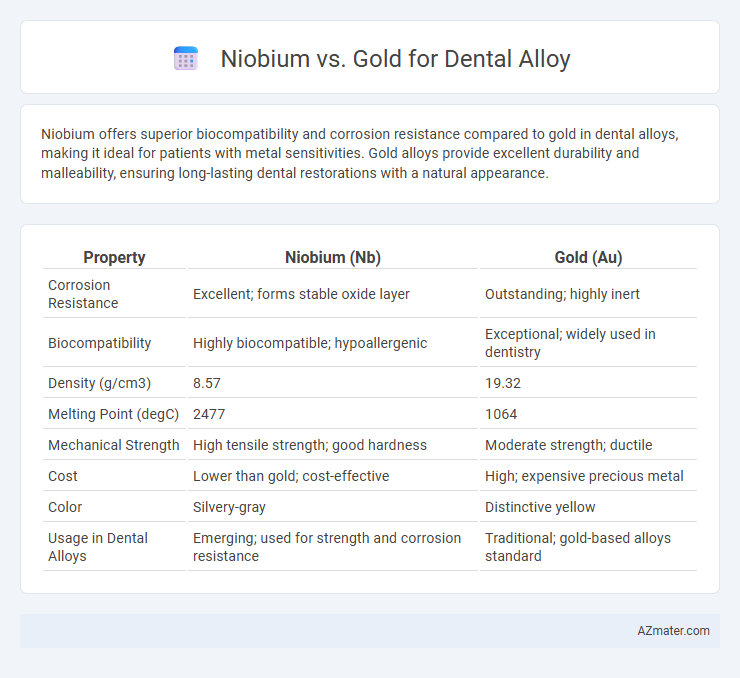Niobium offers superior biocompatibility and corrosion resistance compared to gold in dental alloys, making it ideal for patients with metal sensitivities. Gold alloys provide excellent durability and malleability, ensuring long-lasting dental restorations with a natural appearance.
Table of Comparison
| Property | Niobium (Nb) | Gold (Au) |
|---|---|---|
| Corrosion Resistance | Excellent; forms stable oxide layer | Outstanding; highly inert |
| Biocompatibility | Highly biocompatible; hypoallergenic | Exceptional; widely used in dentistry |
| Density (g/cm3) | 8.57 | 19.32 |
| Melting Point (degC) | 2477 | 1064 |
| Mechanical Strength | High tensile strength; good hardness | Moderate strength; ductile |
| Cost | Lower than gold; cost-effective | High; expensive precious metal |
| Color | Silvery-gray | Distinctive yellow |
| Usage in Dental Alloys | Emerging; used for strength and corrosion resistance | Traditional; gold-based alloys standard |
Introduction to Dental Alloys
Dental alloys are critical materials in restorative dentistry, prized for their strength, biocompatibility, and corrosion resistance. Niobium, a refractory metal, offers excellent corrosion resistance and enhances the mechanical properties of dental alloys when alloyed with other metals. Gold alloys remain the gold standard due to their superior malleability, aesthetic appeal, and long-term durability in dental restorations.
Overview of Niobium and Gold in Dentistry
Niobium offers exceptional biocompatibility and corrosion resistance, making it a promising alternative to traditional dental alloys. Gold remains the gold standard in dentistry due to its durability, malleability, and proven long-term performance in crowns and bridges. Both metals exhibit excellent corrosion resistance, but niobium's strength-to-weight ratio and hypoallergenic properties provide innovative options for modern dental restorations.
Chemical and Physical Properties Comparison
Niobium offers superior corrosion resistance and biocompatibility compared to gold, making it highly suitable for dental alloys exposed to the oral environment. Gold exhibits excellent malleability and ductility, facilitating precise dental restorations, while niobium's higher melting point and hardness contribute to enhanced durability and wear resistance. Both metals form stable oxide layers, but niobium's naturally occurring niobium oxide enhances its chemical stability, reducing ion release and potential allergic reactions in patients.
Biocompatibility and Allergic Reactions
Niobium exhibits high biocompatibility with low allergenic potential, making it a suitable material for dental alloys in patients with metal sensitivities. Gold alloys, while traditionally used in dentistry for their corrosion resistance and durability, can sometimes trigger allergic reactions due to trace metals like nickel or palladium in the alloy composition. Niobium's inert nature reduces the risk of allergic responses, positioning it as an advantageous alternative to gold in dental restorations requiring enhanced biocompatibility.
Strength and Durability in Dental Applications
Niobium-based dental alloys exhibit higher tensile strength and corrosion resistance compared to traditional gold alloys, enhancing their durability in oral environments. Gold alloys provide excellent biocompatibility and malleability but often lack the mechanical robustness needed for high-stress dental restorations. The superior strength-to-weight ratio of niobium alloys ensures longer-lasting dental prosthetics with reduced wear and fracture risk.
Corrosion Resistance and Longevity
Niobium exhibits superior corrosion resistance compared to gold in dental alloys, due to its strong oxide layer that prevents metal degradation in oral environments. Gold alloys, while traditionally favored for their biocompatibility and longevity, can be more susceptible to corrosion, especially in acidic conditions. The enhanced corrosion resistance of niobium contributes to increased longevity and durability of dental restorations, making it a promising alternative in modern prosthodontics.
Esthetic Outcomes: Color and Finish
Niobium dental alloys offer superior esthetic outcomes due to their naturally white-gray color, which closely mimics natural teeth compared to the yellow hue of traditional gold alloys. The high corrosion resistance and stable oxide layer of niobium result in a durable, matte finish that resists tarnishing over time, enhancing long-term appearance. Gold alloys, while malleable and biocompatible, tend to develop a dull patina and their distinct color may require additional aesthetic coatings to match tooth color effectively.
Cost Analysis: Niobium vs Gold
Niobium offers a significantly lower cost alternative to gold in dental alloys, with prices typically ranging between $40 to $50 per kilogram compared to gold's market rate of over $60,000 per kilogram. The affordability of niobium reduces overall treatment expenses while maintaining adequate biocompatibility and corrosion resistance for dental applications. Cost efficiency combined with comparable mechanical properties positions niobium as a promising material for budget-conscious dental restorations.
Clinical Performance and Patient Satisfaction
Niobium dental alloys exhibit superior corrosion resistance and biocompatibility compared to gold, contributing to reduced allergic reactions and enhanced oral health outcomes. Clinical studies show niobium alloys maintain structural integrity under masticatory forces, offering durability comparable to gold while promoting better tissue integration. Patient satisfaction is higher with niobium due to its aesthetic versatility and minimal discoloration over time, outperforming traditional gold alloys in long-term restorative applications.
Choosing the Best Alloy for Dental Restorations
Niobium offers superior biocompatibility and corrosion resistance compared to gold, making it an excellent choice for dental restorations in patients with metal sensitivities. Gold alloys provide exceptional malleability and durability, ensuring long-term stability and natural aesthetics in crowns and bridges. Selecting the best alloy depends on clinical requirements, patient allergies, and budget considerations, with niobium increasingly favored for advanced restorative materials.

Infographic: Niobium vs Gold for Dental Alloy
 azmater.com
azmater.com